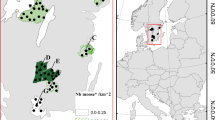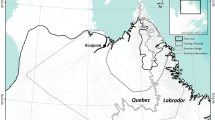Abstract
Summer diet, summer temperature, length of the growth season and animal density appeared to best explain annual and regional differences in calf and yearling body mass in moose from southeastern Norway. In general animals inhabiting steep, alpine landscapes had less body mass than animals using flat, low-altitude habitats. Autumn body mass of calves and yearlings decreased with increasing snow depth during the preceding winter and spring. However, calf body mass was more influenced by the summer range and less by the winter range than was body mass of yearlings. There was no indication that the effect of snow depth on autumn body mass was greater in moose living on poor than on good summer ranges. Body mass decreased with increasing competition for summer forage, while the winter range mainly had an density-independent effect. Habitat quality, expressed as regression lines between calf and yearling body mass and animal density (hunting yield), differed between regions. On ranges of medium and high altitude where birch (Betula spp.) rowan (Sorbus aucuparia) and bilberry (Vaccinium myrtillus) dominated moose summer diet, body mass decreased at a rapid rate with increasing animal density. Body mass decreased at a slower rate at low-altitude ranges and at high-altitude ranges where willow (Salix spp.) and forbs dominated the diet. Body mass of lactating cows decreased with increasing animal density, but animal density did not affect body mass of non-lactating cows. There was no indication that the decrease in autumn body mass with increasing moose density over the last 25 years has caused a decrease in animal condition (ability to survive the winter). The results are discussed in relation to the effect of summer and winter range on population regulation in moose. It is concluded that a density-dependent effect is apparent on the summer range even at low and intermediate population densities. On the winter range, on the other hand, density-dependence is likely to occur only at high levels of population density.
Similar content being viewed by others
Author information
Authors and Affiliations
Additional information
Received: 4 February 1997 / Accepted: 1 February 1999
Rights and permissions
About this article
Cite this article
Hjeljord, O., Histøl, T. Range-body mass interactions of a northern ungulate – a test of hypothesis. Oecologia 119, 326–339 (1999). https://doi.org/10.1007/s004420050793
Issue Date:
DOI: https://doi.org/10.1007/s004420050793




